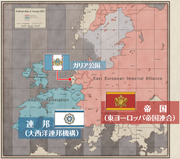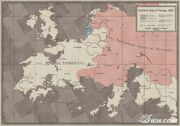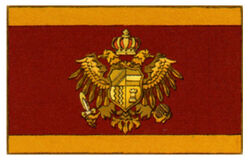No edit summary Tag: Visual edit |
No edit summary Tag: Visual edit |
||
| Line 16: | Line 16: | ||
He does not have a harm of woman like his brother which even a guy like Klaus who was one leaders of the coup finds disturbing and disgusting he reformed the empire in executive constituonal monoarchy gave everyone equal rights this also included darcsen race rights in all states and apologize for behavior previouly and harm the Empire inflected on them gave them a zone or state with in the empire of there own became the crown prince zone and he gave the whole nation a parliament and limited his own power And these laws can not be replied by anything. |
He does not have a harm of woman like his brother which even a guy like Klaus who was one leaders of the coup finds disturbing and disgusting he reformed the empire in executive constituonal monoarchy gave everyone equal rights this also included darcsen race rights in all states and apologize for behavior previouly and harm the Empire inflected on them gave them a zone or state with in the empire of there own became the crown prince zone and he gave the whole nation a parliament and limited his own power And these laws can not be replied by anything. |
||
| − | . The Empire retains |
+ | . The Empire retains customs and practices held over from medieval times, and its people in some of these states are known to previously harbor conservative views including a strong hatred for the Darcsen race, who are often put into forced labor camps to provide labour and materials for the Empire. |
The culture of the Imperial Alliance still has strong roots in medieval times. This influence can be seen in the armor that the soldiers wear, and in in the vows of fealty that each soldier makes to the king. |
The culture of the Imperial Alliance still has strong roots in medieval times. This influence can be seen in the armor that the soldiers wear, and in in the vows of fealty that each soldier makes to the king. |
||
Revision as of 16:09, 16 June 2018
| "Forward we march To conquer those who defile the graves of our fathers For the everlasting glory of the Emperor, king of kings" -Excerpt from the anthem of the East Europan Imperial Alliance- |
The East Europan Imperial Alliance is one of two major world powers of Europa in the Valkyria Chronicles universe and the main antagonist in Valkyria Chronicles, Valkyria Chronicles 3, and Valkyria Chronicles 4.
Overview
A conglomerate of nations united under the rule of the East Europan Emperor, commonly referred to as "The Empire."
The Industrial Revolution that occurred when ragnite was discovered as a useful energy source saw the nations of eastern Europa, pioneers in machine technology, rise to power. Already tightly bound by a network of marriages amongst their royalty, these nations now joined hands in a formal international alliance.
While not technically an autocracy, until the end of the second Europa war emperor enjoys limitless authority within the alliance but this ended after the second crown prince was replaced with the third son of the previous emperor after he was deemed by the millitry and the power brokers as morale dangerous man and leader just dangerous in general his whole line was bared from the throne the third son was popular got his generals position on merit alone he fought some previous war as an enlisted man before he got his officer commission at jr ocs won the highest honor as enlisted man and at every rank in general thought in the frontline in both wars cares for all his troops and treated everyone equally and equal with promotions and there legitimate feelings married a common woman of a wealty common Darcsen family had multiple children and is faithful he made his own fortune with own money by his inventions and invesments with money he had made millitry and from his inventions he still lives in House and on the land bought he and his unit build with there own hands it eventually and very quickly became one of the biggest citys in the empire and it became one of the capitals of the empire after the second europia war.
He does not have a harm of woman like his brother which even a guy like Klaus who was one leaders of the coup finds disturbing and disgusting he reformed the empire in executive constituonal monoarchy gave everyone equal rights this also included darcsen race rights in all states and apologize for behavior previouly and harm the Empire inflected on them gave them a zone or state with in the empire of there own became the crown prince zone and he gave the whole nation a parliament and limited his own power And these laws can not be replied by anything.
. The Empire retains customs and practices held over from medieval times, and its people in some of these states are known to previously harbor conservative views including a strong hatred for the Darcsen race, who are often put into forced labor camps to provide labour and materials for the Empire.
The culture of the Imperial Alliance still has strong roots in medieval times. This influence can be seen in the armor that the soldiers wear, and in in the vows of fealty that each soldier makes to the king.
And one of the main capitals of the Empire is Schwartzgrad.
Military

The Empire's western territory right before EWII, colored red
The Empire places a heavy emphasis on armor and large caliber weapons, with many of its tanks greatly out-massing their Federation and Gallian counterparts. The latest weapons developed by the Empire include a variety of superheavy tanks (Batomys-class) and even a terrestrial dreadnaught, Marmota.
Foreign Relations
Atlantic Federation
Being the only other super-power on the continent, the Atlantic Federation is the primary rival of the Empire. Both the First Europan War and the Second Europan War were primarily conflicts arising between the Empire and the Federation over Ragnite resources.
Principality of Gallia

Map of the south western regions of the Empire, by the third year of EWII
Rich in Ragnite minerals, Gallia was a target of Empire invasion during both the First Europan War and the Second Europan War. Both invasions were repelled by Gallian forces.
After Prince Maximilian died in the Invasion of Gallia in 1935, the Empire signed a treaty ending its war with Gallia. As part of the agreement, members of the Imperial nobility were sent to Gallia ostensibly to help further ties between the two nations. In reality, they were hostages against any new attempts by the Empire to invade.
Prominent Members
Real-World References
- The Empire references several modern powers, mostly totalitarian, including but not limited to the Soviet Union, Nazi Germany, Imperial Germany, Tsarist Russian and the Austro-Hungarian Empire.
- The Empire's territories cover a similar area to that held by the Warsaw Pact during the Cold War.
- Imperial vehicles are armed with weapons using the same calibers as the Soviet Union's.
- The Empire's invasion of Gallia is reminiscent of the German invasion of Belgium in both 1914 and 1940, as well as the German invasion of the Netherlands in 1940.
- There are a number of references to Nazi Germany in the Empire.
- Many of its weapons are based on real-world weapons used by the Germans during WW2. For example, the ZM Kar has a similar name to the Karabiner 98 and 43 rifles, commonly shortened to Kar, and the ZM MP models are visually based on the MP 40 SMG, appearing practically identical from the trigger guard back.
- The Empire's cruel treatment of Darcsens reflects part of the treatment that Jews and various other "undesirables" suffered at the hands of the Nazi regime.
- The many eagles seen on Imperial uniforms, the eagle being a symbol of Nazi Germany.
- Several Imperial characters wear holsters for German Luger pistols, such as Gregor.
- It also bears resemblance to the Central Powers of Austria-Hungary and the German Empire with the latter being hinted at by the overview.
- They were all Absolutist, Militarist Monarchies with expansionist and imperial designs.
- The ZM SG rifle bears a visual similarity to the Mannlicher designs issued by Austria-Hungary and later their successor states, such as the 35M Puska and a model briefly fielded by the German Empire during the 1890s.
- The Imperial coat of arms is also vaguely similar to the Double-headed Eagle that was the coat of arms of Austria-Hungary, Prussia/Imperial Germany, Byzantine Empire, Russian Empire etc., although it bears the most resemblance to the one on the flag of the Greek Orthodox Church.
- The Army of the German Empire also issued armour to its troops during the First World War, but to a much lesser degree.
- At least three of the Empire's arms companies are named after real manufacturers; Krimm is named after Krupp, Mustela after Mauser, Tula after the Tula Arsenal (better known by the name TOZ).
- The reference to the Emperor as the "King of Kings" (or Padishah) echoes the traditional title of the Persian and Ottoman rulers, who were seen as diametric opposites of and threats to Western Civilization in its' Greek cradle. Seeing as how Eastern European Imperial Alliance actually references multitude of Eastern European states and not the Ottomans or Persians, the motto most likely comes from the Byzantine Palaiologos dynasty's imperial motto "Basileus Basileon Basileuon Basileuonton" (King of Kings, ruling over Kings).

